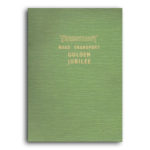Description
The company was founded by Alfred Yarrow ( 1842 – 1932) later Sir Alfred Yarrow, in 1865 as Yarrow & Company, Limited. Originally it was based at Folly Wall, Poplar then in 1898 as the company grew, Yarrow moved his shipyard to London Yard Cubit Town Hundreds of steam launches, lake and river vessels, and eventually the first destroyers for the Royal Navy, the Havock class, were built at Yarrow’s London shipyards between 1869 and 1908. Yarrow was also a builder of boilers, and a type of water-tube boiler developed and patented by the company was known as the “Yarrow Boiler”, first used in a torpedo boat in 1887 and later used for a number of applications, from the propulsion plant of RMS Queen Mary to the LNER class W1 locomotive No. 10,000.
Diversification into boiler manufacturing, including large boilers for electricity generation, meant that the company survived the lean years for shipbuilding. Alfred Yarrow was an inventive naval engineer, and was responsible for a number of novel introductions into service which led to the development of increasingly fast warships. Ultimately in the Royal Navy and abroad it became known that a “Yarrow ship was a fast ship”, with the company building the first naval vessel globally to exceed 30 knots and then, later, 40 knots. Yarrow was made a baronet for services to the war effort in 1916. He was a notable benefactor to many charities.
Yarrows were driven out of London due to skills shortages arising from the decline in the Thames shipbuilding industry, very high local rates and the high costs of transport for steel from the districts where it was made. After careful research (and a great deal of lobbying from other shipbuilding areas!) Yarrows moved to Scotstoun on the Clyde over a two year period (1906-19o8) without significantly affecting production.
It is of interest to note that Thornycroft, the other noted Thames builder of torpedo boats and destroyers, also left in 1908/1909 leaving their yard at Chiswick for Southampton. In their case they were also increasingly handicapped by the necessity of limiting the size of their vessels, which had to be towed under numerous bridges, minus masts funnels and upper works to reach gravesend, where final fitting out took place.
It is rather sad, how often a lavish publication like this, celebrating 100 years, 60 years or 50 years of operation turns out to be something of a “swan song” (one thinks of Thornycroft, Leyland, North British Loco. Etc.) In 1968, Yarrows began a roller coaster existence, becoming part of Upper Clyde Shipbuilders, which folded in 1971. YSL was nationalised by the Labour Government in 1977 as a division of British Shipbuilders. It was denationalised in 1985, and sold to GEC-Marconi. In 1999 Marconi Electronic Systems was sold to British Aerospace, creating BAE Systems Marconi Marine (YSL) then became part of BAE Systems Marine. As of 2009, YSL is now part of BAE Systems Surface Ships, a BAE subsidiary.
I do hope that readers have been able to follow this rigmarole…
One very much doubts if there is any trace of the old Arnold Yarrow Shipbuilders esprit left!



Reviews
There are no reviews yet.